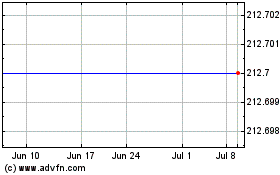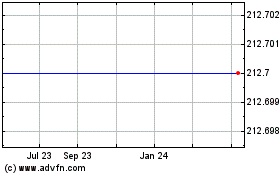Stock Market News for August 2, 2011 - Market News
August 02 2011 - 5:06AM
Zacks
The benchmarks’ roller-coaster ride finally came to a stop with
markets losing modest points, as manufacturing data spoiled the
party after Obama and congressional leaders confirmed they had
reached an agreement on the debt ceiling. Investor mood swayed from
positive to cautious after disappointing ISM data and uncertainty
prevailed ahead of the lawmakers vote on the borrowing limit
issue.
The Dow Jones Industrial Average (DJIA) lost 10 points, or 0.1% to
settle at 12,132.49. Earlier the blue-chip index had soared almost
140 points riding on the announcement by President Obama and the
congressional heads. However, these gains were washed out by
disappointing manufacturing data. The Standard & Poor 500
(S&P 500) shed 0.4% to close at 1,286.94. The Nasdaq Composite
Index also lost 0.4% and finished the day at 2,744.61. On the New
York Stock Exchange, consolidated volumes remained low at 4.4
billion shares and the advance decline ratio was almost
even.
Late on Sunday, President Obama said: “I want to announce the
leaders of both parties in both chambers have reached an agreement
that will reduce the deficit and avoid default.” Thereafter, it was almost a certainty that the
benchmarks would move out of the negative zone and into the green
on Monday. However, this was preceded by another statement where he
said: “There are still some very important votes to be taken by
Congress”, and therefore one could not completely discard the
prevailing uncertainty as many doubted if Congress will approve of
the legislation. The President has
pushed hard for the Bill and insisted that Congress members support
the deal. House Speaker John Boehner also backed the deal and held
a conference call with Republican members to seek their
support.
The deal involves a two-stage process which raises the debt ceiling
and entails deficit reduction measures amounting to $2.4 trillion.
Deficit reduction of $900 billion will take place over 10 years in
the first stage, and in the next stage the congressional committee
will approve an additional $1.5 trillion in deficit-reduction
measures over 10 years. However, $1.2 trillion worth of spending
will automatically take effect if the committee fails to approve
the cuts. President Obama, Senate Democratic leader Harry Reid and
Senate Republican leader Mitch McConnell all opined that the deal
will clear the air of a possible default. However, some believe
that with parts of the deal lacking clarity, this does not
completely rule out the possibility of a rating
downgrade.
It is now left to lawmakers to cast their votes, and they were
expected to do so later during the day or early on Tuesday.
Nonetheless, the deal was required to be approved by midnight
Tuesday to avoid a default. Investors kept their fingers crossed,
as though Senate looked likely to pass the agreement, the House of
Representatives might give the bill a tough ride.
As sentiments turned cautious ahead of the final fate of the debt
deal, manufacturing data dampened investor sentiment, reflecting
weakness in the economy. The Institute for Supply Management said
the U.S. manufacturing sector expanded at its slowest rate in two
years in July. The PMI or the manufacturing gauge receded 4.4
percentage points to 50.9% in July, reflecting the worst reading
since July 2009. Also, production and employment slowed down in
July as compared with June and new orders reflected contraction for
the first time since June 2009. The ISM index has dropped 9.5
percentage points since April and this is the worst three-month
drop since September-to-November 2008.
Healthcare stocks were one of the leading decliners among the 10
groups in the S&P 500. This decline occurred after the
government said it plans to reduce Medicare reimbursement rates by
11%. These cuts are not linked to the debt deal. Stocks like Aetna
Inc. (NYSE:AET), Unitedhealth Group, Inc. (NYSE:UNH), Abbott
Laboratories (NYSE:ABT) and St. Jude Medical Inc. (NYSE:STJ)
dropped 2.9%, 3.2%, 1.7% and 1.3%, respectively.
The debt deal also spurred concerns that the cuts may affect the
Pentagon’s defence budget. Stocks in the sector including, Lockheed
Martin Corporation (NYSE:LMT), Boeing Co. (NYSE:BA), Kratos Defense
& Security Solutions, Inc. (NASDAQ:KTOS) and Northrop Grumman
Corporation (NYSE:NOC) lost 1.7%, 0.2%, 1.9% and 1.5%,
respectively.
ABBOTT LABS (ABT): Free Stock Analysis Report
AETNA INC-NEW (AET): Free Stock Analysis Report
BOEING CO (BA): Free Stock Analysis Report
KRATOS DEFENSE (KTOS): Free Stock Analysis Report
LOCKHEED MARTIN (LMT): Free Stock Analysis Report
NORTHROP GRUMMN (NOC): Free Stock Analysis Report
ST JUDE MEDICAL (STJ): Free Stock Analysis Report
UNITEDHEALTH GP (UNH): Free Stock Analysis Report
Zacks Investment Research
Aetna (NYSE:AET)
Historical Stock Chart
From May 2024 to Jun 2024

Aetna (NYSE:AET)
Historical Stock Chart
From Jun 2023 to Jun 2024
